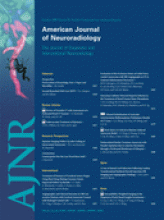In this densely informative pocket-sized Handbook of Cerebrovascular Disease and Neurointerventional Technique, Drs Harrigan and Deveikis compiled a 760-page soft-cover book, which takes the reader through virtually every neurovascular abnormality amenable to interventional therapy and the techniques for each. The book is divided into 3 sections: 1) “Fundamentals,” 2) “Interventional Techniques,” and 3) “Specific Disease States.” Under “Fundamentals” the authors describe and illustrate, with line drawings and angiography, all the pertinent vascular anatomy. This anatomy is not for the resident learning angiography—it is highly detailed. Rather, it is the anatomy all interventionalists must know, but like the rest of the book, it is heavy reading. That gets to another issue related to the book: The font size is very small, to include all this information into a pocket-sized book that will fit in a lab coat (the handbook needed to come with complimentary reading glasses).
The authors meticulously take the reader through each procedure step by step, including all aspects of the study and interventional treatment, including preprocedural evaluation, preprocedureal orders, personnel requirements, contrast used, procedural medications, sedation and anesthesia, recommended catheter/guidewires/other devices, steps in device manipulation, suggested tips and techniques during the procedure, and postprocedural care/orders. There is much more to the book than a “cookbook” approach to various disorders. There are sections on organizing and staffing a neurovascular suite, equipment (both angiographic and auxiliary) needed, room requirements, radiation safety, availability of medications, and much more. Many sections on disease treatments are accompanied by line drawings, which are of great importance when reading about certain procedures such as balloon-assisted or stent-assisted coiling in the treatment of wide-neck aneurysms. The detail given for each procedure is so complete as to be nearly overwhelming (you cannot risk not having sufficient detail to cover every circumstance).

This is not a dreary manual because interspersed are comments, tips, and editorial-like discussions to keep the sections interesting. Examples of this abound throughout; for instance under pharmacologic provocative testing, the Wada test is described from a historic perspective and from a “strange, but true” and “more strange, but true” view, in addition, of course, to all the nuances of the test itself. Likewise under “Transvenous Stent Placement,” “Background Material” gives insight into the diseases treated with this procedure and the pertinent anatomic/physiologic considerations. After the section “Fundamentals” (141 pages including “Essential Neurovascular Anatomy,” “Diagnostic Cerebral Angiography,” “Spinal Angiography,” and the “Neurovascular Suite”), the major categories of diseases and disorders covered include intracranial aneurysm treatment, provocative testing, treatment of arteriovenous malformations, treatment of dual arteriovenous fistulas, cavernous malformations and venous angiomas, acute stroke, vascular occlusive disease (both intracranial and extracranial), and spinal vascular lesions. Even for neuroradiologists who are not involved in interventional procedures, this book would be a worthwhile purchase because not only does it spell out the issues that interventionalists deal with on a daily basis but it also contains valuable diagnostic information. All the material on acute ischemic stroke (69 pages written separately by Dr Ardelt is just 1 such example) nicely complements the separate 45-page chapter “Thrombolysis for Acute Ischemia Stroke.”
The index (which in a book like this is a key component) is 28 pages long, robust, and subdivided well, so everything I could think of was included. There are abundant references at the end of each chapter. This is an extremely valuable handbook and should find its way into every neurointerventional suite and/or lab coat pocket of every resident, fellow and staff member involved in these cases. It is highly recommended—you will have to thumb through a copy of this book at a meeting where Humana Press is displaying their volumes to realize that this book needs to be readily available wherever these procedures are performed.
- Copyright © American Society of Neuroradiology







